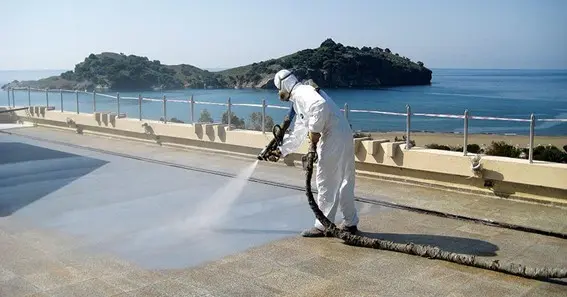Applying polyurea to a roof and parapet wall is an excellent way to ensure long-lasting durability and effective waterproofing. Polyurea is a high-performance coating known for its flexibility, quick curing time, and resistance to weathering. This makes it a top choice for protecting both roofs and parapet walls from harsh environmental elements, including UV rays, rain, and wind. Below, we explore the benefits and the steps involved in applying polyurea for these surfaces.
Benefits Of Using Polyurea On Roofs and Parapet Walls
1. Seamless Waterproofing
Polyurea is applied as a liquid, which creates a seamless membrane across the roof and parapet wall. This eliminates common weak points like seams and joints, significantly reducing the potential for leaks. A polyurea coating provides continuous protection, even on complex structures and around rooftop penetrations like vents and HVAC units.
2. Durability and Weather Resistance
Polyurea coatings are highly resistant to abrasion, UV rays, and chemical exposure. This makes them ideal for both flat and sloped roofs, as well as the vertical surfaces of parapet walls. The material’s elasticity allows it to handle structural movements without cracking, which is particularly beneficial for areas exposed to temperature fluctuations.
3. Fast Application and Curing
One of polyurea’s standout advantages is its rapid curing time. Unlike traditional waterproofing methods, polyurea dries within minutes, reducing downtime and making it possible to complete projects quickly. This is especially beneficial for commercial properties where minimizing operational disruption is critical.
Application Process for Polyurea on a Roof and Parapet Wall
- Surface Preparation: Clean the roof and parapet wall thoroughly, removing any debris, dirt, or loose materials. Make sure the surface is dry and smooth, as proper adhesion is crucial for a successful polyurea application.
- Priming: Depending on the substrate (metal, concrete, or wood), a primer may be necessary to enhance the bond between the surface and the polyurea coating. Choose a primer that is compatible with the specific polyurea product being used.
- Polyurea Application: Use a spray machine to apply the polyurea in even layers, starting with the roof surface and extending up to the parapet wall. The spray application allows for quick and precise coverage, ensuring a uniform thickness throughout the area.
- Detail Work: Pay special attention to corners, seams, and roof penetrations. Polyurea’s seamless nature allows it to wrap around these details without leaving gaps, providing thorough protection against water ingress.
- Curing: Allow the polyurea to cure completely. This usually takes only a few minutes to an hour, depending on the specific product and environmental conditions. Once cured, the coating forms a durable, flexible, and protective barrier.
FAQ
- Why choose polyurea for roofs and parapet walls?
- Polyurea offers seamless, long-lasting protection that is resistant to weather, UV rays, and mechanical damage, making it ideal for roofs and parapet walls.
- Is polyurea suitable for all types of roofs?
- Yes, polyurea can be applied to a wide range of substrates, including metal, concrete, and wood, making it versatile for different roofing materials.
- How quickly does polyurea cure after application?
- Polyurea typically cures within minutes, allowing for quick project turnaround and minimal disruption.
- Can polyurea handle temperature changes?
- Yes, polyurea’s elasticity allows it to expand and contract with temperature changes without cracking, making it suitable for various climates.
- What is the lifespan of a polyurea-coated roof and parapet wall?
- A polyurea coating can last several decades with proper maintenance, significantly outlasting traditional waterproofing solutions.
Dive into an intriguing read plausawa-hill-tower-nh-down-what-was-on-it
- A polyurea coating can last several decades with proper maintenance, significantly outlasting traditional waterproofing solutions.










